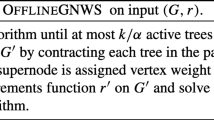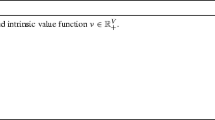Abstract
We study the static pricing problem for a network service provider in a loss system with a tree structure. In the network, multiple classes share a common inbound link and then have dedicated outbound links. The motivation is from a company that sells phone cards and needs to price calls to different destinations. We characterize the optimal static prices in order to maximize the steady-state revenue. We report new structural findings as well as alternative proofs for some known results. We compare the optimal static prices versus prices that are asymptotically optimal, and through a set of illustrative numerical examples we show that in certain cases the loss in revenue can be significant. Finally, we show that static prices obtained using the reduced load approximation of the blocking probabilities can be easily obtained and have near-optimal performance, which makes them more attractive for applications.





Similar content being viewed by others
Notes
In this last case, N 2<N but it is large enough to fall in the complete-sharing case. That is why the two prices are identical.
References
Avriel, M., Diewert, W. E., Schaible, S., & Zang, I. (1988). Generalized concavity. New York: Plenum.
Carrizosa, E., Conde, E., & Muñoz-Márquez, M. (1998). Admission policies in loss queueing models with heterogeneous arrivals. Management Science, 44(3), 311–320.
Courcoubetis, C. A., & Reiman, M. I. (1999). Pricing in a large single link loss system. In P. Key & D. Smith (Eds.), Teletraffic engine in a competitive world (pp. 737–746). Amsterdam: Elsevier.
Courcoubetis, C. A., & Weber, R. R. (2003) Pricing communication networks. Chichester: Wiley.
Harel, A. (1990). Convexity properties of the Erlang loss formula. Operations Research, 38(3), 499–505.
Kelly, F. P. (1991). Loss networks. The Annals of Applied Probability, 1(3), 319–378.
Kenevan, J. R., & von Mayrhauser, A. K. (1984). Convexity and concavity properties of analytic queueing models for computer systems. In E. Gelenbe (Ed.), Performance’84 (pp. 361–375). Amsterdam: Elsevier, North-Holland.
Lanning, S., Massey, W. A., Rider, B., & Wang, Q. (1999). Optimal pricing in queueing systems with quality of service constraints. In P. Key & D. Smith (Eds.), Teletraffic engineering in a competitive world (pp. 747–757). Amsterdam: Elsevier.
Lin, X., & Shroff, N. B. (2005). Simplification of network dynamics in large systems. IEEE/ACM Transactions on Networking, 13(4), 813–826.
Martínez-de-Albéniz, V., & Simchi-Levi, D. (2006). Mean-variance trade-offs in supply contracts. Naval Research Logistics, 53(7), 603–616.
Mendelson, H. (1985). Pricing computer services: queueing effects. Communications of the ACM, 28(3), 312–321.
Paschalidis, I. Ch., & Tsitsiklis, J. N. (2000). Congestion-dependent pricing of network services. IEEE/ACM Transactions on Networking, 8(2), 171–184.
Paschalidis, I. Ch., & Liu, Y. (2002). Pricing in multiservice loss networks: static pricing, asymptotic optimality, and demand substitution effects. IEEE/ACM Transactions on Networking, 10(3), 425–438.
Pinsky, E., & Conway, A. E. (1992). Computational algorithms for blocking probabilities in circuit-switched networks. Annals of Operations Research, 35, 31–41.
Ross, K. W. (1995). Multiservice loss models for broadband telecommunication networks. New York: Springer.
Ross, K. W., & Tsang, D. (1990). Algorithms to determine exact blocking probabilities for multirate tree networks. IEEE Transactions on Communications, 38(8), 1266–1271.
Ross, K. W., & Yao, D. D. (1990). Monotonicity properties of the stochastic knapsack. IEEE Transactions on Information Theory, 36(5), 1173–1179.
Rudin, W. (1976). Principles of mathematical analysis. New York: McGraw-Hill.
Strzebonski, A. (1994). An algorithm for systems of strong polynomial inequalities. The Mathematica Journal, 4(4), 74–77.
Wolff, R. W., & Wang, C. (2002). On the convexity of loss probabilities. Journal of Applied Probability, 39, 402–406.
Ziya, S., Ayhan, H., & Foley, R. D. (2008). A note on optimal pricing for finite capacity queueing systems with multiple customer classes. Naval Research Logistics, 55, 412–418.
Author information
Authors and Affiliations
Corresponding author
Additional information
Research supported in part by the Center of eBusiness at MIT, ONR Contracts N00014-95-1-0232 and N00014-01-1-0146, and by NSF Contracts DMI-9732795, DMI-0085683 and DMI-0245352.
Rights and permissions
About this article
Cite this article
Caro, F., Simchi-Levi, D. Optimal static pricing for a tree network. Ann Oper Res 196, 137–152 (2012). https://doi.org/10.1007/s10479-012-1115-4
Published:
Issue Date:
DOI: https://doi.org/10.1007/s10479-012-1115-4




